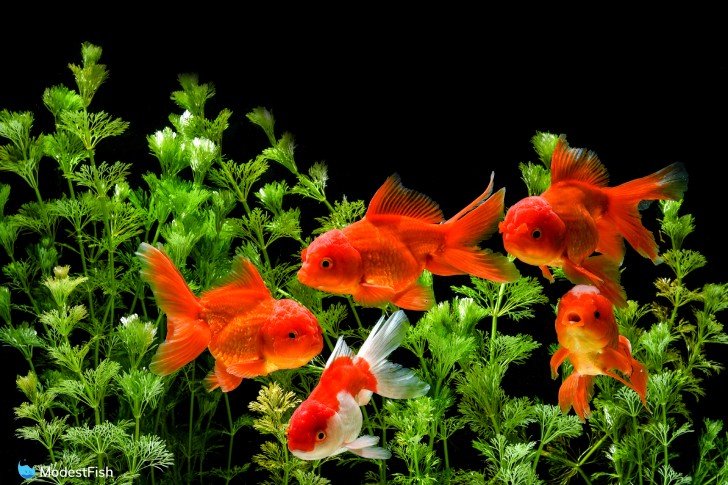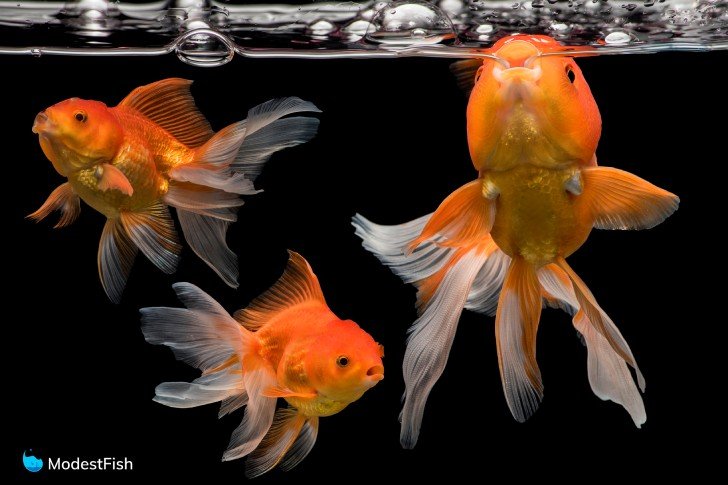Breeding goldfish is a lot of work, and it’s not always a pleasurable experience.
But, it is possible with these methods on how to breed goldfish below.
How to Sex Goldfish

Your first step is to tell the boys from the girls, but this can be a little tricky with goldfish.
All of these methods depend on the fish being in spawning condition.
Body Shape
This is not always the best method, but it can be a good clue.
When they’re ready to breed, female goldfish get heavier-bodied and plumper than the males.
This is easiest to see when you look at them from above.
Females may even seem a bit asymmetrical when seen from above because they carry their eggs mostly on one side of their body.
Males should look slimmer and more long-bodied.
Breeding Stars
Breeding stars are tiny little tubercles. That’s fancy science talk for a small, round growth on the surface of an animal or plant.
They’re made of keratin, the same stuff that forms hair and fingernails.
They look like little white dots that appear on the gill covers, pectoral rays and/or scales of the male fish when he’s ready to spawn.
Pro Tip: The number and pattern of breeding stars can vary from fish to fish. They can also fade or emerge throughout the breeding season.
And every once in a while, just to make life difficult, a female will show breeding stars.
Vent
Once goldfish are getting close to spawning, the vent (anus) on the fish can start to change.
Usually, males have a longer vent that’s indented while a female’s vent will start to stick out a little bit once she’s close to spawning.
A lot of people compare them to human belly buttons, saying males have an “innie” and females have an “outie.”
Behavior
When the mood starts to hit them, goldfish will let you know who’s a boy and who’s a girl by their behavior.
This is probably the most reliable way to sex goldfish.
Male goldfish will start to constantly chase the females. The males often shove their heads into the female’s tail and try to push her around the tank.
You may see more than one male pursue a female.
You’ll see them do this again and again so it starts to become abundantly clear who’s male and who’s female.
Conditioning Goldfish for Breeding

Spawning takes an enormous amount of energy, especially for the females. So your fish need to have enough of a fat reserve so they can expend the needed energy to produce eggs and milt.
Conditioning should start about 6 months before spawning. Protein rich foods like earthworms and bloodworms should be added to the fish’s staple foods.
Goldfish naturally spawn in the late spring and early summer. The period of cold winter weather, followed by warmer spring weather, triggers their bodies to start spawning.
If your goldfish are kept in a pond, it’s important to watch for spawning behavior once the air temperature starts to rise. If your fish are tank raised, you’ll need to simulate spring by adding a heater to your tank and gradually increasing the heat to around 75°F (24°C).
How to Breed Goldfish
One thing to consider if you’re going to breed goldfish, you’re going to need a separate tank to raise fry in.
Adult goldfish pretty much live to eat and will gobble up baby fish.
Natural Method
Equipment:
- Spawning mops (look below for more info)
- 18 gallon plastic totes
- Rocks or suction cups
Steps:
- When you see the males start to chase your chosen female, fill the plastic totes with enough water that the fish can swim comfortably.
- Place a spawning mop in the corner of the tote and secure it with rocks or suction cups.
- Move the female and two males into the tote.
- Watch the fish for mating behavior. The males should shove the female into the spawning mop and they will wriggle vigorously. You should start to see round, whitish eggs stuck to the mop.
- After the fish make several passes laying eggs, move the mop to the tank you plan to raise your fry in.
- Put a fresh mop into the container with the parents and let them lay eggs on that one until you no longer see mating behavior.
- Move the second mop into your fry tank.
What’s a Spawning Mop?
A spawning mop is a manmade device that mimics a mat of live plants. It’s made out of green synthetic yarn tied together so it resembles the head of a string mop.
In the wild, a male goldfish will chase the female into the plants and ram into. This causes the female to release eggs so he can fertilize them.
The goldfish will lay their eggs on the spawning mop, just like it was a real plant.
Goldfish eggs are sticky, so they adhere to the strings of the mop. Then the mop can easily be removed to another tank to hatch the eggs and raise the fry.
Pro Tip: Here’s a handy tutorial on how to make your own spawning mop.
Hand Breeding
So, what’s hand breeding you may ask?
Well, basically, you lightly squeeze the goldfish to get them to release eggs and milt into the water.
Yep, sometimes Mother Nature needs a little help.
Equipment:
- 2 plastic basins (16 inch/3 gallon)
Steps:
- Fill the basins with enough tank water that the fish can comfortably swim.
- Place the female and at least two males into one of the basins.
- Gently pick up one of the males. Flip the fish upside down and lightly rub his belly toward his vent. Milt should immediately start to stream out.
- Every few seconds, stir the water with your free hand to mix the milt evenly.
- Put the male back into the first basin.
- Gently pick up the female, flip her upside down over the other basin. Lightly rub her belly toward her vent. Eggs should immediately come out in bursts with each stroke. If not, the female is not ready to spawn yet and needs more time.
- Make sure you stir the water after each small burst of eggs, you don’t want them to stick together.
- Place the female back into the first basin and collect milt from the second male.
- Repeat this process back and forth between the males and the female until the female stops producing eggs.
- Return the parents to their tank.
- The eggs will be stuck to the bottom of the basin. After about half an hour, swap out the water in the basin for fresh tank water.
Raising Fry
OK. So you’ve got a bunch of fertilized goldfish eggs.
Now what the heck do you do?
Once you’ve gotten the parents to spawn, the real work begins.
Experts recommend that you hatch eggs in no more than 6 inches (15 centimeters) of water or you risk the weight of the water crushing them.
The eggs will need aeration, but it has to be very gentle.
It’s best to use an airstone with the flow turned almost all the way down. That way it bubbles just a little bit and breaks the surface tension, but doesn’t blast the fry around.
It’s best for the water to be kept at a steady temperature between 70°-75°F (21°-24°C).
The eggs will hatch in 2-4 days. The fry will live off their yolk sacks for several days and won’t require feeding.
About two days after hatching, the fry should become free swimming and they will be HUNGRY.
The best food for them is freshly hatched baby brine shrimp.
Pro Tip: For more information on hatching brine shrimp, please check out this video.
Culling Fry
OK this is never an easy subject.
The truth is, when you spawn hundreds of fish, you’ll end up with a good number that have undesirable characteristics, like poor tail shape, bent spines or irregular fins.
It happens to everyone.
Lots of seasoned breeders will tell you that you have to thoroughly cull and eliminate undesirable fish.
They would argue that these fish aren’t worth the resources to raise since no one will want them. And you shouldn’t risk them breeding and passing on their problems.
And technically, they’re right. To breed quality fish, that people will want to buy, the not so great ones just take up needed resources and shouldn’t be bred.
But, for me, as a soft-hearted fish lover, the idea of having to kill a bunch of fry I’ve carefully raised from tiny eggs sounds horrible. So I understand anyone who balks at this.
Breeders often put undesirable fry in with the adults who will gladly gobble them up.
Pro Tip: You could also euthanize your culled fish if that makes you more comfortable.
So, this is something you should ask yourself before you start breeding: are you up to the task of culling fry?
If not, maybe this isn’t the right project for you.
Is Breeding Goldfish Right for You?
I’m not going to sugarcoat it, there’s a lot of work involved in breeding goldfish.
The fish will readily spawn, but your first hurdle is to spawn them in a controlled way so that the adults don’t just eat all the babies.
Once you’ve got fertilized eggs, there’s quite a bit of work involved just to raise the fry.
You have to be willing to hatch baby brine shrimp to feed them, a chore in and of itself, and the tank will require frequent water changes.
You’ll also need the room to house huge numbers of fry as they grow out and an outlet to sell or trade them once they get up to size.
And there’s the not-so-pleasant task of culling fish with undesirable traits.
I’m not trying to discourage anyone from doing something that’s really important to them, but at the same time, I don’t want anyone to suddenly be stuck with 100 fry that they can’t take care of or baby fish that are starving to death because someone didn’t know they’d need baby brine shrimp.
I think breeding fish is a really rewarding endeavor that can even make you a little bit of side money. But it’s also a huge responsibility.
I hope I’ve given you the information you need to decide if this is right for you and I wish you all the best if you decide to take on this labor of love.

Thanks for your Info sir . It is very applicable for us as a beginners. Thanks a lot.